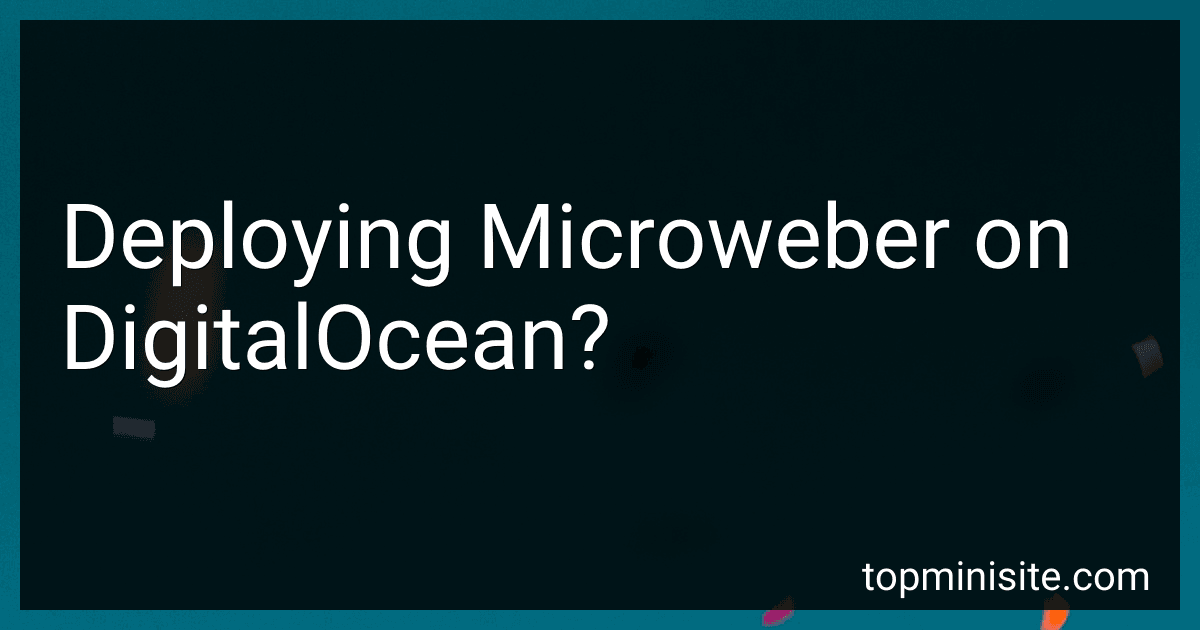Best Web Deployment Solutions to Buy in December 2025

Web Hosting For Dummies



The Ultimate cPanel Guide (Web Hosting with cPanel)



Building Your Own Web Server: A Hands-On Approach to Hosting Your Website: Understand the inner workings of web hosting by setting up your own server from scratch.



WordPress To Go: How To Build A WordPress Website On Your Own Domain, From Scratch, Even If You Are A Complete Beginner



Funny You Should Ask: How to Make a Website: The 100% Not Boring Guide to Setting Up Your Website with Wordpress (Funny You Should Ask: Breaking Down Internet Marketing, Publishing, SEO and More)



The Ultimate WHM Guide (Web Hosting with cPanel)



Web Development with Blazor: A practical guide to building interactive UIs with C# 12 and .NET 8



Modern Web Development: A Beginner's Guide to HTML, CSS, Hosting, and SEO



Complete Blueprint on How to Start Your Own Web Hosting Company


To deploy Microweber on DigitalOcean, you need to follow several steps:
- Create a DigitalOcean account and log in to the dashboard.
- Click on the "Create" button and select "Droplets" from the dropdown menu.
- Choose a server size based on your project requirements and select a datacenter region.
- Select the desired operating system, such as Ubuntu, and choose the version you prefer.
- Scroll down and enable backups if needed. You can also add block storage if necessary.
- Choose a hostname for your droplet or leave it as the default one.
- To configure additional settings, click on "Add SSH Keys" to set up secure access for your droplet.
- Click on the "Create Droplet" button at the bottom to start the deployment process.
- Once the droplet is created, DigitalOcean will display the IP address of your server.
- Use an SSH client, such as PuTTY (for Windows) or Terminal (for macOS and Linux), to establish an SSH connection to your droplet using the provided IP address.
- After logging in, update the system packages by running the following command: sudo apt-get update
- Install Apache web server by running the command: sudo apt-get install apache2 -y
- Next, install PHP to run Microweber by running the command: sudo apt-get install php libapache2-mod-php php-mysql -y
- Install the necessary PHP extensions: sudo apt-get install php-curl php-intl php-mbstring php-xml php-zip -y
- Create a new virtual host configuration file to set up the website. Use the following command to create the file: sudo nano /etc/apache2/sites-available/microweber.conf
- Add the following content to the file: ServerAdmin webmaster@localhost DocumentRoot /var/www/html Options FollowSymLinks AllowOverride All Require all granted ErrorLog ${APACHE_LOG_DIR}/error.log CustomLog ${APACHE_LOG_DIR}/access.log combined
- Save and exit the file by pressing Ctrl + X, followed by Y, and then Enter.
- Enable the newly created virtual host by running the command: sudo a2ensite microweber.conf
- Disable the default Apache virtual host by running the command: sudo a2dissite 000-default.conf
- Restart the Apache web server to apply the changes: sudo service apache2 restart
- Download the Microweber package and extract it to the /var/www/html directory: cd /var/www/html sudo wget https://microweber.com/download?typr=zip -O microweber.zip sudo unzip microweber.zip sudo rm microweber.zip
- Set the appropriate ownership and permissions for the Microweber files: sudo chown -R www-data:www-data /var/www/html sudo find /var/www/html -type f -exec chmod 644 {} \; sudo find /var/www/html -type d -exec chmod 755 {} \;
- Open a web browser and visit your server's IP address. You will be prompted to set up Microweber with the necessary configuration details.
That's it! You have successfully deployed Microweber on DigitalOcean. You can now proceed with the installation and setup of your Microweber-powered website.
How to connect to a DigitalOcean droplet through SSH?
To connect to a DigitalOcean droplet through SSH, follow these steps:
- Open the terminal on your local machine.
- Retrieve the IP address of your DigitalOcean droplet.
- Ensure that you have the SSH key associated with your droplet. If you don't, you can add one in the DigitalOcean dashboard by going to "Settings" > "Security" > "SSH Keys" and then clicking on the "Add SSH Key" button. You can find instructions on how to generate an SSH key if you don't have one already in the DigitalOcean documentation.
- In your terminal, use the SSH command along with the username and IP address of your droplet. The username might vary depending on the operating system of your droplet. For example, if your droplet is running Ubuntu, the default username is usually "root": ssh root@your_droplet_ip_address Replace your_droplet_ip_address with the IP address of your droplet.
- If you have multiple SSH keys, you can specify the one to use with the -i flag: ssh -i /path/to/your/private_key root@your_droplet_ip_address Replace /path/to/your/private_key with the actual path to your private key file.
- If this is your first time connecting to the droplet, you might see a warning about the authenticity of the host. Verify that the fingerprint matches the one shown in the DigitalOcean dashboard and type "yes" to proceed.
- If everything is set up correctly, you should be connected to your DigitalOcean droplet via SSH and can start executing commands on the droplet through the terminal.
Remember to replace any placeholders (your_droplet_ip_address or /path/to/your/private_key) with the appropriate values specific to your setup.
What is the recommended image optimization strategy for Microweber on DigitalOcean?
When optimizing images for Microweber on DigitalOcean, it is recommended to follow these strategies:
- Image Compression: Optimize images by compressing them without significant loss in quality. Use image compression tools like TinyPNG, JPEG Optimizer, or ImageOptim to reduce file sizes.
- Image Resizing: Resize images to the actual size required on the webpage. Avoid using larger images and scaling them down using CSS or HTML. Use image editing software like Adobe Photoshop or online tools like Pixlr to resize images.
- Image Format: Choose the appropriate image format to balance quality and file size. JPEG is ideal for photographs, while PNG is suitable for graphics, icons, and images with transparency. Avoid using uncompressed formats like BMP or TIFF.
- Lazy Loading: Implement lazy loading techniques to load images only when they are visible on the screen. This reduces the initial page load time. There are plugins available for Microweber that enable lazy loading, such as Lazy Load XT or the built-in Lazy Load option.
- Content Delivery Network (CDN): Utilize a CDN to distribute your images across multiple servers globally. This improves image loading speed by serving images from the nearest server to the user. DigitalOcean Spaces, Amazon S3, or Cloudflare are popular CDN services that can be integrated with Microweber.
- Caching: Implement a caching mechanism for your Microweber website. Caching stores static content like images to minimize server requests and load pages faster. Configure caching plugins specifically designed for Microweber, such as LiteSpeed Cache or WP Super Cache.
By following these image optimization strategies, you can improve the performance and ensure faster loading times for your Microweber website on DigitalOcean.
What are the system requirements for Microweber on DigitalOcean?
To run Microweber on DigitalOcean, you would need a server with the following system requirements:
- Operating System: Ubuntu 18.04 (LTS) or later, or CentOS 7 or later.
- Web Server: Apache 2.4 or Nginx 1.14 or later.
- Database: MySQL 5.7 or MariaDB 10.2 or later.
- PHP: version 7.2 or later, with the following extensions installed: gd, curl, mbstring, zip, xml, dom, json, pdo, and pdo_mysql.
- Disk space: At least 1GB free disk space for the base installation, however, additional space might be required depending on the size of the website you want to build.
Additionally, you may also need to configure your web server to point to the correct directory where Microweber is installed and set appropriate file permissions.
It is always recommended to check the official Microweber documentation or support channels for the most up-to-date system requirements and installation instructions.
